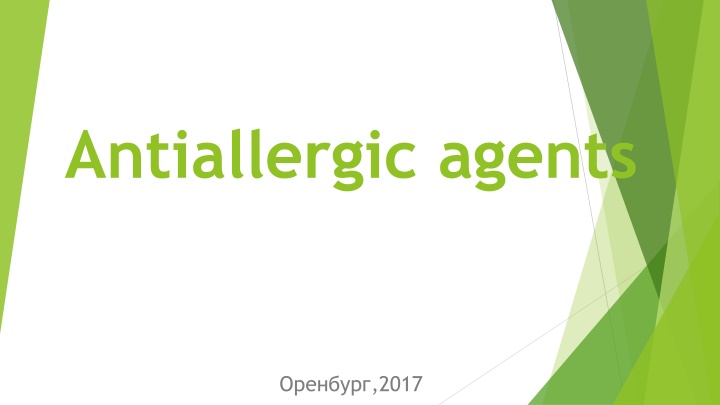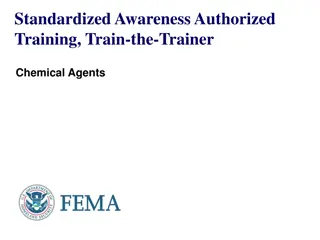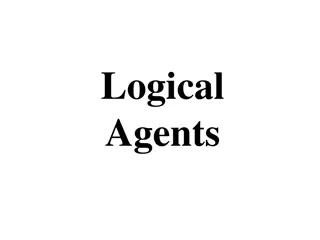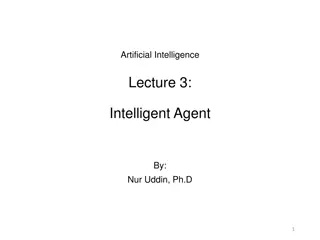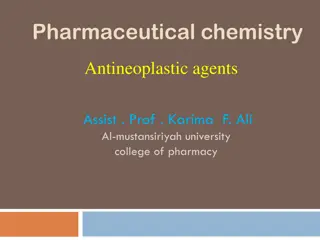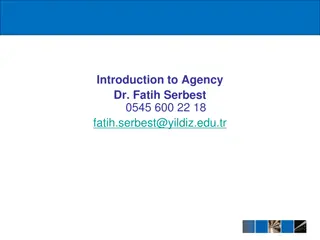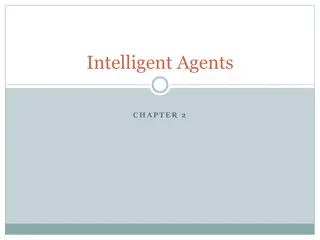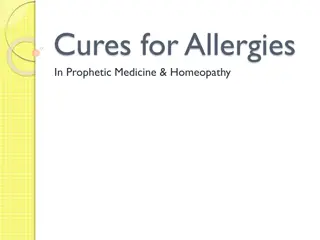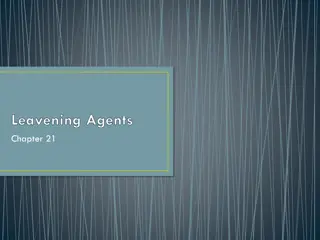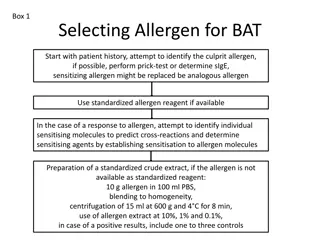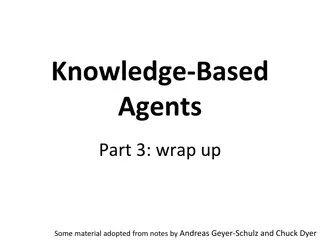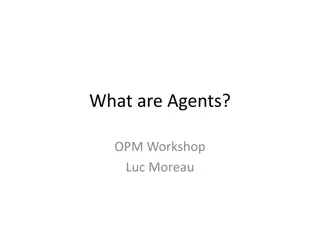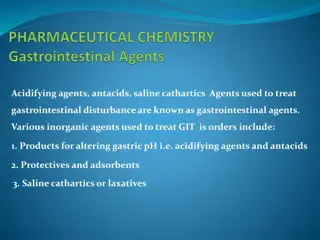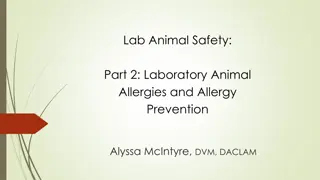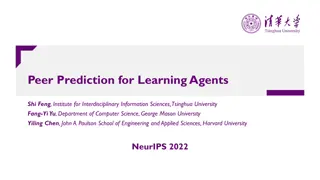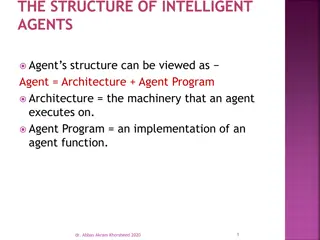Allergies and Antiallergic Agents
Allergies are hyperreactivity conditions caused by particular substances called allergens. The immune response plays a key role in allergic reactions, which occur in three stages: immunologic, pathochemical, and pathophysiological. These reactions can manifest immediately or with a delayed onset. Antiallergic agents aim to alleviate symptoms and manage allergic reactions.
Download Presentation

Please find below an Image/Link to download the presentation.
The content on the website is provided AS IS for your information and personal use only. It may not be sold, licensed, or shared on other websites without obtaining consent from the author.If you encounter any issues during the download, it is possible that the publisher has removed the file from their server.
You are allowed to download the files provided on this website for personal or commercial use, subject to the condition that they are used lawfully. All files are the property of their respective owners.
The content on the website is provided AS IS for your information and personal use only. It may not be sold, licensed, or shared on other websites without obtaining consent from the author.
E N D
Presentation Transcript
Antiallergic agents ,2017
The allergy - (from Greek allos-other, ezgon-action) is the condition of a hyperreactivity of an organism developing at repeated influences of particular substances.
At the heart of the allergy is the immune response, which flowing past with tissue damage. The substances causing an allergy are called allergens. At effect of allergens on an organism allergic reaction is formed. The development mechanism which can represent on the following scheme.
Allergic reaction proceeds in 3 stages.
1 stage is called immunologic: At action of an antigen the system of humoral immunity is activated, and antibodies which are localized on mast cells are formed. Antigenmast cell humoral immunity fixing (sheaf) mast cell IMMUNOLOGIC STAGE
At repeated hit the 2nd stage develops in an organism: The antigen interacts with antibodies on a surface of mast cells. It causes degranulate of mast cells and selection of allergy mediators from them: Histaminums, bradikinina, leykotriyena. leukotrieni PATOCHEMICAL STAGE bradykinin histamine
3 stage: As a result of the subsequent action of mediators on specific receptors in bodies and fabrics develops allergic reactions which are shown in the form of stretching of vessels, increase in a transmittivity of their walls, hypostasis of fabrics, decrease in a AD and a bronchospasm. receptors LTr BRr HISr PATHOPHYSIOLOGICAL STAGE
On the nature of manifestation allergic reactions are subdivided on: 1) Reactions of immediate type (in a few minutes after repeated contact with allergen) It is anaphylactic shock, a Quincke's disease, an urticaria, an itch, hay fever. 2) Reactions of delayed type (arise in 2-3 days) Reactions of a casting-off of a transplantant, a contact dermatitis etc. concern to them
Principles of treatment of allergic reactions: 1) Immediate termination of contact with allergen 2) Specification of the nature of allergen (pollen of plants, hair of animals, medicinal substances) 3) Purpose of antiallergic tools
Classification of antiallergic medicines. I. The tools which are slowing down development of an immunologic stage. 1) MEDICINES OF GLUCOCORTICOIDS - Prednisolonum - Dexamethazonum - Triamcinolone
II. The tools interfering degranulate of mast cells and selection of Histaminum, leykotriyen 3) M - HOLINOBLOKATOR A) Not selection M1,M2, M3 - Atropinum Methacinum - Itrop B) The selection M3 - holinobloktara - Tiotropy 4) BRONCHIAL SPASMOLYTICS OF MYOTROPIC ACTION - Theophyllinum - Aminophyllinum 5) BLOCKERS OF CALCIUM CHANNELS - Kromolin of sodium - nedokromit - Ketotifenum 1) MEDICINES OF GLUCOCORTICOIDS - Prednisolonum - Dexamethazonum 2) -ADRENOMIMETIKI A) not the selection and, - adrenomimetiki - adrenaline B) not selection 1 2 of an adrenomimetika - Isadrinum C) the selection 2-adrenomimetik - Salbutamolum Fenoterolum
III. Tools, the interfering interactions of mediators of allergic reaction with bodies targets. 1) BLOCKERS OF H1-HISTAMINIC RECEPTORS - Dimedrol Tavegilum Suprastinum - Klaritin - A rius -Diazolinum 2) TOOLS WITH ANTILEYKOTRIYENOVY ACTION A) inhibitors LOG - Zileuton B) blockers leykotriyenovykh of receptors -Zafirlukast
Glucocorticoids Medicines: Analogs of natural hormones - Hidrocortizonum Synthetic medicines - Prednisolonum - Dexamethazonum - Triamcinolone
Pharmacodynamics(mechanism of action): The mechanism of antiallergic action is connected with three components 1) Break interaction of macrophages with antigens i.e. blocks an antigen presentation stage. 2) Brake activity of a phospholipase of A2 which participates in formation of arachidonic acid of which it is formed leykotriyena subsequently mediators of allergic reaction. Recycl ing AG Active BL PL JgM+AG Predece ssor BL macrophage BL PL JgM+AG
Indication for use: 1. nafilaktichesky shock 2. Asthmatic status 3. Quincke's edema 4. Eczema 5. Psoriasis
Side effects: 1. Itsenko's syndrome - Cushing 2. Steroid ulcers 3. Steroid diabetes mellitus 4. Arterial hypertension
- adrenomimetiki Not the selection and, - adrenomimetik - adrenaline
Pharmacodynamics(mechanism of action);: 1) Stimulates 2 adrenoreceptors of bronchial tubes and causes broncholitic effect 2) Stimulates 1 adrenoreytseptor of heart and causes cardiotonic effect 3) excites a1 adrenoreceptors of vessels and causes a vasoconstriction that leads to increase in a AD
Indication for use 1) Anaphylactic shock 2) Attacks of bronchial asthma
Side effects 1) Tachycardia 2) Arterial hypertension 3) Cardiac arrhythmia
Not selection b1 b 2 of an adrenomimetika - Isadrinum
Pharmacodynamics(mechanism of action): 1) Stimulates b2 adrenoreceptors of bronchial tubes and causes broncholitic effect 2) Stimulates b1 adrenoreceptors of heart and causes cardiotonic effect
Indication for use 1) Bronchospasms 2) AV-blockade
Side effects 1) Tachycardia 2) Cardiac arrhythmia 3) Arterial hypertension
The selection b2- adrenomimetik - Salbutamolum Fenoterolum
Pharmacodynamics(mechanism of action): Selectively adrenoreceptors of bronchial tubes stimulate only B2 and cause a bronchospasm. Medicines stimulate B2 adrenoreceptors of bronchial tubes and activate adenylatecyclase, fortify TsAMF that leads to decrease in level of calcium. The input of calcium is limited. Calcium channels are closed and concentration of calcium decreases. there is a decrease in a tone of bronchial tubes and the broncholitic effect is observed At the same time stimulate b2 adernoretseptor of mast cells where also activate adenylatecyclase and at the same time the TsAMF level increases, the calcium input via calcium channels as a result of it mnizhatsya degranulate and release of Histaminum is slowed down that also results in bronkholitichsky effect
Indication for use: 1) Attacks of bronchial asthma 2) Prophylaxis of attacks of asthma
Side effects:In case of an overdose bronchial obstructive effect is possible.Dispensing mode: Appoint in the form of aerosols two breaths at an attack no more than 6 times a day
Not selection M1,M2, M3 - Holinoblokator - Atropinum Methacinum - Itrop
Pharmacodynamics(mechanism of action): Block M3 holinoretseptor and cause broncholitic effect. Block M-2 holinoretseptor and cause cardiotonic effect. Block m-1 holinoretseptor and cause a mydriasis and paralysis of accommodation.
Indication for use: 1) Attacks of bronchial asthma 2) Basic therapy of bronchial asthma
The selection M3 - holinobloktar - Tiotropy
Pharmacodynamics(mechanism of action): Medicine blocks m3-holinoretseptory the gladkomyshechnykh of cells of bronchial tubes, activity of a guanilattsiklaza is braked, the Ts-GMF level decreases. In a rezuldtata of it the calcium input is blocked, its level decreases and develops broncholitic effect Blocks m-holinoretseptory in mast cells. The guanilattsiklaza is braked, the Ts-GMF level decreases, calcium channels, a calcium input are blocked Emission of Histaminum is as a result slowed down and that also promotes broncholitic effect
Indication for use: 1) Prophylaxis of attacks of bronchial asthma
Side effects: 1) tachycardia 2) heartaches 3) Increase in an ophthalmotonus 4) Dryness in a mouth
Bronchial spasmolytics of myotropic action - Theophyllinum - Aminophyllinum Release forms: Tablets and solutions for injections
Pharmacodynamics (mechanism of action). Medicines have direct miorelaksiruyushchy action on unstriated muscles of bronchial tubes and cause broncholitic effect In High doses of relatives to toxic blocks FDE that also promotes accumulation of Ts-AMF and decrease in level of calcium. What sometimes strengthens action of b2- adrenomimetik
Indication for us: 1) attack of bronchial asthma 2) Prophylaxis of attacks of asthma
Side effects: 1) Hypotensive reaction
Blockers of calcium channels -Cromolyn sodium - Nedocromil - Ketotifen
Pharmacodynamics(mechanism of action): Block calcium channels and reduce calcium ions in the gladkomyshechnykh cells of bronchial tubes, causes broncholitic effect Indications to application: -Basic therapy of bronchial asthma
Tools, the interfering interactions of mediators of allergic reaction with bodies targets Blockers of H1-histaminic receptors - Dimedrol Tavegilum Suprastinum - Diazolinum -Klaritin - Erius
Pharmacodynamics(mechanism of action): Medicines block H-1 histaminic receptors in internals and interfere with action of Histaminum on them. Thus eliminate symptoms of allergic reaction.
Indication for use: 1) Urticaria 2) Allergic rhinitises 3) Allergic conjunctivitis 4) Polinoza 5) Itch
Side effects: 1) Depressing of a CNS shown: sleepiness, reduction in the rate of motive reaction 2) Atropinopodobny action: dryness in a mouth, tachycardia, a mydriasis 3) Ganglioblokiruyushchy action - hypotonic reaction 4) The irritant action which is shown a dyspepsia 5) Mestnoanesteziruyushchy action at medicine reception inside.
Medicines with antileykotriyenovy action A) inhibitors of LOG -zileuton
Pharmacodynamics(mechanism of action): Blocks a lipoxygenase and slows down synthesis of leykotriyen which are mediators of allergic reaction. As a result symptoms of an allergy are suppressed.
